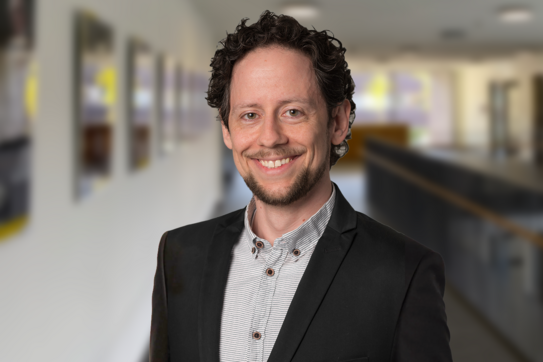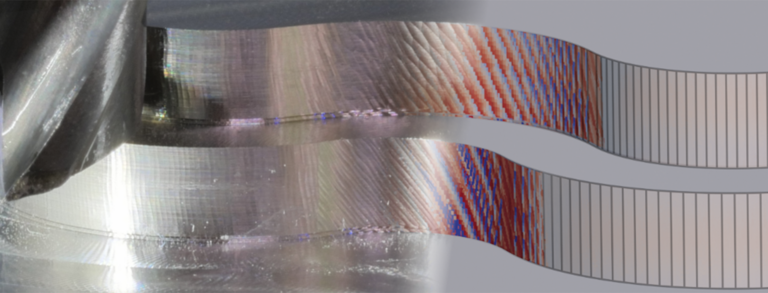Jim A. Bergmann, M.Sc.
E-Mail
jim.bergmanntu-dortmundde
Telefon
(+49) 231 755-2412
Büro
Otto-Hahn-Str. 12, R. 2022
Adresse
Technische Universität Dortmund
Fakultät für Informatik - Virtual Machining
Otto-Hahn-Straße 12
44227 Dortmund

Forschungsschwerpunkte
- Entwicklung von Simulationssystemen zur Abbildung von Fertigungsprozessen
- Geometrische Modellierung von Werkzeugkomponenten
- Konzeption von Ersatzmodellen zur Abbildung von Prozesskräften und -dynamik
- Verarbeitung und Analyse von Messdaten zur Prozessbewertung
Ich bin Research Associate im Lamarr-Institute für Maschinelles Lernen und Künstliche Intelligenz im Forschungsbereich Industrie und Produktion.

Forschungsprojekte
Netzwerke
Betreute Abschlussarbeiten (Auswahl)
- Entwicklung eines Analyseframeworks zur dexelbasierten Modellierung der Randzonenbeeinflussung in Abhängigkeit der NC-Strategie bei Fräsprozessen
- Simulation von robotergestützten Druckluft-Nassstrahl-Spanprozessen zur Optimierung der Prozesspfade für vorgegebene Schneidengestalten
- Entwicklung einer Methodik zur Anpassung von Bauteil-Topologien zur Reduktion von Formabweichungen beim selektiven Laserschmelzen
- Approximation digitalisierter Zerspanwerkzeugtopografien unter Nutzung strukturierter Gitternetze
- Identifikation von Formabweichungen additiv gefertigter Bauteile für die Auslegung spanender Nachbearbeitung
Veröffentlichungen
2025
A Simulation-Based Approach for the Estimation of Inclination-Dependent Material Removal and Subsurface Influence in Wet Abrasive Jet Machining
Bergmman, J.A., Peters, J., Polat, C., Kipp, M., Biermann, D., Wiederkehr, P.
Procedia CIRP, In press.
Modeling topographical variations of cutting edges to consider the stochastic behavior of tool wear in milling simulations
Bergmann, J.A., Wiederkehr, P.
Procedia CIRP, 133 (2025): 483-488
DOI: https://doi.org/10.1016/j.procir.2025.02.083
2024
Geometric physically-based simulation of microfinishing: Tool design impact on workpiece shape
Siebrecht, T., Bergmann, J.A., Heining, I., Tilger, M., Biermann, D., Wiederkehr, P.
Production Engineering - Research and Development (2024)
DOI: https://doi.org/10.1007/s11740-024-01309-8
Simulation of process forces and topographical characteristics of single grains in microfinishing processes
Heining, I., Bergmann, J.A., Tilger, M., Biermann, D., Wiederkehr, P.
Production Engineering - Research and Development (2024)
DOI: https://doi.org/10.1007/s11740-024-01285-z
2023
A systematic approach for data acquisition and analysis of spindle speed-dependent modal parameters
F. Wöste, J. A. Bergmann and P. Wiederkehr
Procedia CIRP, 118(2023): 205-210
DOI: https://doi.org/10.1016/j.procir.2023.06.036
Simulation-based analysis for the machining of thin-walled, additively manufactured support structures
E. Jaeger, J. A. Bergmann and P. Wiederkehr
Procedia CIRP, 118(2023): 454-458
DOI: https://doi.org/10.1016/j.procir.2023.06.078
An analysis of the sensitivity of cutting force coefficients and their influence on the variability of stability diagrams
J. A. Bergmann, F. Wöste and P. Wiederkehr
Production Engineering - Research and Development (2023)
DOI: https://doi.org/10.1007/s11740-022-01181-4
2022
A methodology to integrate process-induced subsurface characteristics into a digital twin-based framework for the evaluation of machining processes
J. A. Bergmann, F. Wöste and P. Wiederkehr
Procedia CIRP 107 (2022): pp. 125-130
DOI: https://doi.org/10.1016/j.procir.2022.04.021
2021
A Synthesis-based Tool Path Planning Approach for Machining Operations
T. Schäfer, J. A. Bergmann, R. G. Carballo, J. Rehof and P. Wiederkehr
Procedia CIRP 104C (2021), pp. 917-922
DOI: https://doi.org/10.1016/j.procir.2021.11.154
Deformation Behavior of 42CrMo4 Over a Wide Range of Temperatures and Strain Rates in Split-Hopkinson Pressure Bar Tests
J. S. Kimm, J. A. Bergmann, F. Wöste, F. Pöhl, P. Wiederkehr and W. Theisen
Materials Science and Engineering: A (August 2021)
DOI: https://doi.org/10.1016/j.msea.2021.141953
Modeling of cutting forces in trochoidal milling with respect to wear-dependent topographic changes
J. A. Bergmann, N. Potthoff, T. Rickhoff and P. Wiederkehr
Production Engineering - Research and Development (2021)
DOI: 10.1007/s11740-021-01060-4
Investigation of the effect of residual stresses in the subsurface on process forces for consecutive orthogonal cuts
F. Wöste, J. Kimm, J. A. Bergmann, W. Theisen and P. Wiederkehr
Production Engineering - Research and Development (2021)
DOI: 10.1007/s11740-021-01058-y
Modeling of the Split-Hopkinson-Pressure-Bar experiment with the explicit material point method
S. F. Maassen, R. Niekamp, J. A. Bergmann, F. Pöhl, J. Schröder and P. Wiederkehr
Computational Particle Mechanics; April 2021
DOI: 10.1007/s40571-021-00399-w
2020
An approach to use sub-surface characteristics for the prediction of process forces during cutting operations
J. A. Bergmann, J. Kimm, W. Theisen and P. Wiederkehr
Procedia CIRP, 88 (2020): 276-281
DOI: 10.1016/j.procir.2020.05.048
Experimental setup for analyzing fundamentals of cutting processes using a modular system
F. Wöste, J. Baumann, J. A. Bergmann, R. Garcia-Carballo and P. Wiederkehr
Modern Machinery (MM) Science Journal, March 2020: 3754-3758
DOI: 10.17973/MMSJ.2020_03_2020004
2019
Analytical and Simulation-Based Prediction of Surface Roughness for Micromilling Hardened HSS
A. Meijer, J. A. Bergmann, E. Krebs, D. Biermann and P. Wiederkehr
Journal of Manufacturing and Materials Processing, 3 (2019) 3, p. 70
DOI: 10.3390/jmmp3030070
Trochoidal milling: investigation of dynamic stability and time domain simulation in an alternative path planning strategy
F. A. Niaki, A. Pleta, L. Mears, N. Potthoff, J. A. Bergmann and P. Wiederkehr
The International Journal of Advanced Manufacturing Technology (2018): 1-16
DOI: 10.1007/s00170-018-03280-y
2018
An interdisciplinary view on the formulation of a process force model for milling processes
J. Kimm, J. A. Bergmann, S. Kugai, J. Schröder, W. Theisen and P. Wiederkehr
Materials Chain International Conference 2018
Deformation behaviour and chip formation processes of tempering steel under high-speed deformation and high temperature: a microstructural analysis
J. Kimm, J. A. Bergmann, S. Kugai, F. Pöhl, P. Wiederkehr and W. Theisen
Sino-German Summer School 2018 (chinesich-deutsches Zentrum für Wissenschaftsförderung)
An integrated macroscopic model for simulating SLM and milling processes
P. Wiederkehr and J. A. Bergmann
Production Engineering. Research and Development 12(2018) 3
DOI: 10.1007/s11740-018-0822-3
2017
Stochastische Modellierung von Kornverteilungen beim Microfinishen mit deterministischen Finishbändern
T. Siebrecht, M. Tilger, T. T. Dereli, M. Kipp, F. Finkeldey, J. A. Bergmann, S. Schumann, D. Biermann and P. Wiederkehr
4. Fachtagung "Sensitive Fertigungstechnik", Magdeburg, H. Goldau (Hrsg), R. Stolze (Hrsg), Shaker Verlag, ISBN 978-3-8440-6397-4, (2017), 167–174
Makroskopische Simulation generativer Fertigungsverfahren am Beispiel des Selective Laser Melting
Master Thesis
Interne Berichte TU Dortmund, Fakultät Informatik, 2017
2015
Modeling of Surface Location Errors in a Multi-scale Milling Simulation System Using a Tool Model Based on Triangle Meshes
T. Siebrecht, P. Kersting, D. Biermann, S. Odendahl and J. Bergmann
Procedia CIRP, 37 (2015), S. 188-192
DOI: 10.1016/j.procir.2015.08.064







